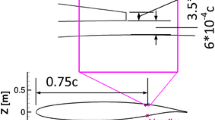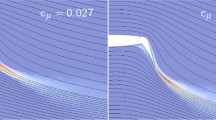Abstract
Extended configurations of a short take-off and landing aircraft under investigation at the Coordinated Research Centre SFB 880 include a morphing droop nose and a tractor propeller engine. The short take-off and landing capabilities are achieved by circulation control via a high velocity jet over the flap leading edges utilizing the Coandǎ effect. The effect of the engine integration in combination with the blown flaps on the wing sizing, aerodynamic performance, and static wing deformation are of large interest. High-detail structural wing models are sized with a fully stressed approach using a partitioned fluid–structure interaction process. The aerodynamic part is covered by highly detailed computational fluid simulations. The effect of modeling the engine on the global and local aerodynamics for different levels of circulation control has a large impact. In addition, a change in flow separation behavior due to the engine effects is observed. The wing mass is only slightly increased by the detailed engine aerodynamics and the separation behavior changes slightly for the elastic wing. These findings show that the modeling of the engine will lead to a different stall behavior and allow for a higher lift, while the influence on the wing structure and aeroelasticity are very small.






















Similar content being viewed by others
References
Deal, P., Grunwald, K.J., Hall, A.: Flight investigation of performance characteristics during landing approach of a large powered-lift jet transport. Tech. rep. (1967)
Diekmann, J.H., Hahn, K.U.: Effect of an active high-lift system failure during landing approaches. CEAS Aeronaut. J. 6(2), 181–196 (2015)
Dinkler, D., Krukow, I.: Flutter of circulation-controlled wings. CEAS Aeronaut. J. 6(4), 589–598 (2015). https://doi.org/10.1007/s13272-015-0166-z
Englar, R.J., Smith, M.J., Kelley, S.M., Rover III, R.C.: Application of circulation control to advanced subsonic transport aircraft. Part I-airfoil development. J. Aircr. 31(5), 1160–1168 (1994). https://doi.org/10.2514/3.56907
Englar, R.J., Smith, M.J., Kelley, S.M., Rover III, R.C.: Application of circulation control to advanced subsonic transport aircraft. Part II-transport application. J. Airc. 31(5), 1169–1177 (1994). https://doi.org/10.2514/3.46627
Griffin Jr, R.N., Holzhauser, C.A., Weiberg, J.A.: Large-scale wind-tunnel tests of an airplane model with an unswept, aspect-ratio-10 wing, two propellers, and blowing flaps. Tech. rep. (1958)
Haas, D., Chopra, I.: Static aeroelastic characteristics of circulation control wings. J. Aircr. 25(10), 948–954 (1988). https://doi.org/10.2514/3.45684
Haas, D., Chopra, I.: Flutter of circulation control wings. J. Aircr. 26(4), 373–381 (1989). https://doi.org/10.2514/3.45770
Haupt, M., Niesner, R., Unger, R., Horst, P.: Computational aero-structural coupling for hypersonic applications. In: 9th AIAA/ASME joint thermophysics and heat transfer conference, pp. 5–8 (2006). https://doi.org/10.2514/6.2006-3252
Innis, R.C., Holzhauser, C.A., Quigley, H.C.: Airworthiness considerations for stol aircraft. Tech. rep. (1970)
Keller, D.: Numerical approach aspects for the investigation of the longitudinal static stability of a transport aircraft with circulation control. In: New results in numerical and experimental fluid mechanics IX, pp. 13–22. Springer, Berlin (2014). https://doi.org/10.1007/978-3-319-03158-3
Keller, D., Rudnik, R.: Numerical investigation of engine effects on a transport aircraft with circulation control. J. Aircr. 52(2), 421–438 (2015). https://doi.org/10.2514/1.C032724
Korbacher, G.: Aerodynamics of powered high-lift systems. Annu. Rev. Fluid Mech. 6(1), 319–358 (1974). https://doi.org/10.1146/annurev.fl.06.010174.001535
Lighthill, M.: Notes on the deflection of jets by insertion of curved surfaces, and on the design of bends in wind tunnels. Reports and memoranda 2105, Aeronautics Research Council (1945)
Österheld, C.M. (ed.): Physikalisch begründete Analyseverfahren im integrierten multidisziplinären Flugzeugvorentwurf. Shaker (2004). Doctoral dissertation
Puck, A., Schürmann, H.: Failure analysis of frp laminates by means of physically based phenomenological models. Compos. Sci. Technol. 58(7), 1045–1067 (1998)
Radespiel, R., Heinze, W.: SFB 880: fundamentals of high lift for future commercial aircraft. CEAS Aeronaut. J. 5(3), 239–251 (2014). https://doi.org/10.1007/s13272-014-0103-6
Rao, A.R.M., Arvind, N.: A scatter search algorithm for stacking sequence optimisation of laminate composites. Compos. Struct. 70(4), 383–402 (2005). https://doi.org/10.1016/j.compstruct.2004.09.031
Rendall, T., Allen, C.: Efficient mesh motion using radial basis functions with data reduction algorithms. J. Comput. Phys. 228(17), 6231–6249 (2009). https://doi.org/10.1016/j.jcp.2009.05.013
Schwamborn, D., Gardner, A., von Geyr, H., Krumbein, A., Lüdecke, H.: Development of the DLR TAU-code for aerospace applications. In: Proceedings of the international conference on aerospace science and technology, pp. 26–28. Bangalore, India (2008)
Sommerwerk, K., Haupt, M.: Design analysis and sizing of a circulation controlled CFRP wing with Coandă flaps via CFD-CSM coupling. CEAS Aeronaut. J. 5(1), 95–108 (2014). https://doi.org/10.1007/s13272-013-0093-9
Sommerwerk, K., Krukow, I., Haupt, M., Dinkler, D.: Investigation of aeroelastic effects of a circulation controlled wing. AIAA Journal of Aircraft (Advance online publication), 1–11 (May 20, 2016). https://doi.org/10.2514/1.C033780
Spalart, P., Allmaras, S.: A one-equation turbulence model for aerodynamic flows. AIAA Paper 92-0439 (1992). https://doi.org/10.2514/6.1992-439
U.S. Department of Defense: MIL-HDBK-17-2F: Composite materials handbook. Polym. Matrix Compos. Mater. Prop. 2, 152–163 (2002)
Wilkerson, J.: Aeroelastic characteristics of a circulation control wing. Tech. Rep. 76-0115, David W. Taylor Naval Ship Research and Development Center (1976). https://doi.org/10.2514/3.45684
Wood, N.: Circulation control airfoils—past, present, future. Tech. Rep. 85-0204, AIAA (1985). https://doi.org/10.2514/6.1985-204
Young, T.: Outlines of experiments and inquiries respecting sound and light. Philos. Trans. R. Soc. Lond. 90, 106–150 (1800)
Acknowledgements
The authors gratefully acknowledge the funding as part of the Coordinated Research Center 880 provided by the German Research Foundation (Deutsche Forschungsgemeinschaft—DFG). The computations were made possible through access to the resources of the North-German Supercomputing Alliance (Norddeutscher Verbund zur Förderung des Hoch-und Höchstleistungsrechnens—HLRN).
Author information
Authors and Affiliations
Corresponding author
Rights and permissions
About this article
Cite this article
Sommerwerk, K., Michels, B., Haupt, M.C. et al. Influence of engine modeling on structural sizing and approach aerodynamics of a circulation controlled wing. CEAS Aeronaut J 9, 219–233 (2018). https://doi.org/10.1007/s13272-018-0290-7
Received:
Revised:
Accepted:
Published:
Issue Date:
DOI: https://doi.org/10.1007/s13272-018-0290-7




